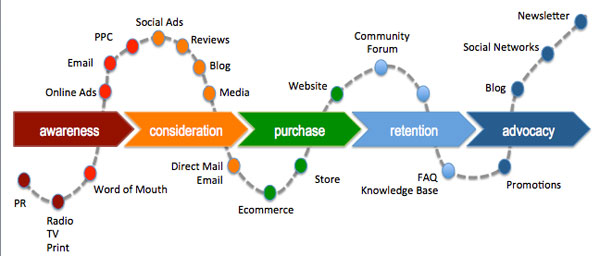 Most forms of online B2B marketing and advertising focus on attracting and engaging business customers through a sales cycle to create awareness and interest, through consideration and ultimately to purchase. That’s reasonable since there’s a clear investment and return.
Most forms of online B2B marketing and advertising focus on attracting and engaging business customers through a sales cycle to create awareness and interest, through consideration and ultimately to purchase. That’s reasonable since there’s a clear investment and return.
While a lot of social media-savvy business to business companies are leveraging social channels to engage with communities and for customer service, most implementations of corporate social media marketing are no different than any other sales-focused marketing effort. Expectations are high to influence a social return on investment (ROI).
In fact, a recent survey by PulsePoint Group and The Economist Intelligence unit reports that, “Executives who said their companies had established an extensive social media presence reported a return on investment that was more than four times that of companies with little or no social network engagement activity.”
However, is the traditional B2B sales cycle still the most relevant way to think of online marketing tactics like social media, search, and content marketing? Isn’t there more to the brand and customer relationship where content and social media play an active role?
Business customers are empowered to publish now more than ever and increasingly expect social interactions from industry peers and the companies they do business with as well as their friends and co-workers. These expectations and interactions occur beyond the path to purchase and provide companies with an opportunity to leverage social content and engagement beyond the sales cycle to retention and advocacy.
Advocacy is the best form of advertising. Inspiring word of mouth referrals through optimized social content can amplify the benefits of a more holistic approach to B2B content and social media.

Companies and individuals interact on social networks and media-sharing sites and the outcome is often content, but how effective is that content at inspiring action? There are many ways to be more effective with social content creation, sharing, and engagement beyond the typical sales cycle. How do you find and take advantage of those opportunities?
You can start by answering some important questions about the relationship between your brand and your customers:
Audit Brand and Customer Interactions
- How do you connect with customers online with content throughout the lifecycle? Awareness, knowledge, consideration, selection, satisfaction, advocacy, and loyalty.
- What do your customers think of those interactions?
- How do they respond?
- How does the brand measure up? What is the sentiment?
- What are the brand opportunities to improve those interactions for mutual benefit?
- Where is the brand missing out on interactions because there is no content being published for that phase in the customer relationship?
- How can existing social media and content marketing strategies be extended beyond the buying cycle to advocacy and loyalty?
By digging into how existing customer and brand interactions occur, companies can optimize their content marketing strategy to better leverage social media. It also sets the stage for a more strategic approach to leveraging content in the social media marketing mix.
Besides an online marketing strategy, there’s an operational aspect to being more strategic about social media marketing across the customer lifecycle. Here are a few important considerations:
Strategic Approach to Optimizing Connections Between Customers and Brands With Content
- Win internal support, develop effective process, and share a vision on how to scale.
- Communicate goals to the teams involved and executives that need to approve.
- Assess readiness and skills internally.
- Develop training, process, and support.
- Create feedback mechanisms to inspire continued participation (internally and customers).
- Conduct customer research: segments, profiles, and personas.
- What are customer behaviors and expectations?
- What preferences do they have for information and interaction throughout the lifecycle relationship with the brand?
- Develop a content strategy that identifies editorial, promotion, and PR efforts.
- Coordinate paid, owned, earned, and shared media according to your approach for customer lifecycle marketing.
- Make sure content is findable, shareable, useful, and actionable across the spectrum.
- Establish monitoring and measurement initiatives to track progress and analyze results.
- Develop a process to bring real-time insights from monitoring and analysis from interaction data back to the planning process for a continuous process of optimization.
How will you know your efforts to optimize content and social media interactions from awareness to advocacy are achieving your goals? By assessing the signals that represent productive customer lifecycle interactions and success. Social media content is better viewed as the assist to sales vs. the channel for sales.
Key Performance Indicators
- Social KPIs. Fans, friends, followers, comments, likes, shares, votes, and ratings (benchmark, trends, growth, and quality).
- Social topics. Used in relation to brand name and sentiment (relevance to brand USP and key messages, relevance to what customers care about, and pain points and solutions).
- Search KPIs. Brand vs. non-brand search keywords and website content (product/sales info, HR jobs, news, customer service/support/FAQ/knowledge base).
- Business outcomes.
- Sales. Inquiries, up-sell/cross-sell, upgrades, order frequency, volume, and net profit.
- Social engagement. Trend of brand mentions, referrals, endorsements, links/shares, and sentiment over time.
- Public relations. Unsolicited MSM news pickups, online media blogs, media inquiries, and analyst inquiries.
- Human resources and recruiting. Candidate inquiries from search- and social-optimized content.
- Customer service. Rate of traditional support inquiries vs. web visits to support content, and service solutions delivered via social channels.
The rush to revenue with social media and any other content-focused Internet marketing approach can compromise innovation and shortcut the long-term value of more meaningful (vs. mechanical) social media marketing and community building. Consider the entire spectrum of how your brand can create awareness and interest, influence transactions, and continue in a cycle to retain and advocate referrals for awareness to even more new customers.
Do the homework and continue to study how your brand can continuously and holistically optimize content and social media participation to attract, engage, and inspire your customers. The result? More sales and longer, more meaningful customer relationships.
A version of this article originally appeared in my ClickZ column, Social Media Smarts.
At SES San Francisco, I will be giving a presentation that implements many of these perspectives into a B2B Content Marketing context:
Optimize B2B Content Across the Sales Cycle
Wednesday, August 15 – 9:00am
With today’s fast moving search and social web, content flows in every direction throughout a variety of platforms, formats and devices. The mass adoption of social platforms has facilitated a revolution of B2B information access, sharing and publishing. Now more than ever, guiding business customers on their journey through the sales cycle requires an integrated approach to content, optimization and social media marketing. This session will help solve that challenge by providing:
- A framework for sales funnel optimization for specific customer segments
- Case studies on developing content, optimization, promotion and measurement for search and social media
- Practical examples for optimizing Awareness, Interest, Consideration, Purchase, Retention and Advocacy
- Key performance indicators that lead to business outcomes with an integrated approach
I hope to see you there!


